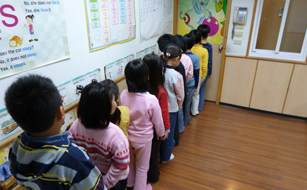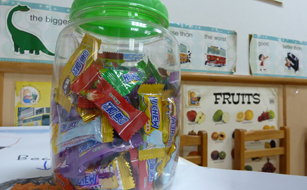Children are so competitive
By user • Dec 19th, 2010 • Category: Diary
The following is an excerpt from a forthcoming collection of short stories about living abroad in Taiwan.
I punched Amy when we were inside a Buddhist temple. Hard. Without warning. In the shoulder. When she wasn’t looking. One minute, we were quietly minding our business admiring the intricate, handcrafted floral designs. Then, the next minute, WHACK! Although she deserved it, the maniacal laughter and victory dance that followed probably were uncalled for.
“What is wrong with you?” she snapped, spinning around aggressively with a look as though I’d done something wrong.
We were visiting a centuries-old shrine built upward into a rural Taiwanese mountainside. The impressive holy grounds’ ornate architecture stretched for the equivalent of several city blocks and was decorated from floor to ceiling in rare gemstones and gold. Amy’s voice was muted, but, despite her best efforts, sounded more like a harsh snarl than a whisper as it echoed through the cavernous corridor and reverberated off the priceless trinkets and statues.
Deciphering her mood takes practice. A divide exists between a relatively harmless disposition and a much more volatile frame of mind. For all her patience, that invisible line is unforgiving.
They sound similar, but “I’m embarrassed (I spilled my soda.),” is much safer territory than “You’re embarrassing (Stop explaining to my grandfather why fingers that shoot water would be the most useful super power.).” To the untrained observer without years spent in the emotional trenches, “I’m annoyed (Traffic was bad.),” might be mistaken for the far more dangerous, “You’re annoying (I don’t want to watch any more online videos of cats.).
“I’m frustrated (I can’t get my hair to look right.),” certainly isn’t, “You’re frustrating (You’ve tried on a dozen shirts; pick one so we can leave.).”
“I’m surprised (Sautéed cabbage actually is quite good.),” is not the same as, “You’re surprising (Did you really spend that much on an out-of-print Material Issue album?).”
There are subtleties in her facial expressions and tones of voice that shouldn’t be left to the inexperienced observer. The look on her face after I hauled off and clocked her at the base of a 20-foot-tall Buddha statute didn’t say, “That hurt.” It said, “You’re about to hurt.” Yet, I knew I hadn’t broken any rules of engagement. Slugging her was fair play.
“Monk thunk,” I said, with my hands still thrust overhead and lower half wiggling like a child with a bursting bladder.
“What? Ugh, where?” she exclaimed, exasperated and rubbing her arm therapeutically while scanning the large room. 
Monk Thunk is a game akin to Slug Bug. Generations of siblings have spent cross-country road trips with eyes peeled for Volkswagen Beetles, just waiting for the opportunity to take a swing at the other. Monk Thunk is the East Asian version – admittedly concocted in a spirit contradictory to Buddhism. At least the German car has a tangential connection to its nation’s violent history. Our game conversely celebrated a religion built upon tranquility and tolerance by resorting to force and loud boasting.
Children are so competitive.
It’s the only explanation for a game such as Slug Bug. There’s no ultimate winner. There’s no time limit. There isn’t even an official start. It has no game board, pieces, field of play, or rulebook. Many times, a person doesn’t know he or she has been drafted into an ongoing round of Slug Bug until an initial smack in the arm sends their mood plummeting from that of a peaceful sightseer into a vengeful rage.
This simplest of games – look, shout, punch, repeat – is evidence of an unbridled desire to compete that lurks throughout childhood. Everything can be a contest. Spotting a novelty automobile – or religious figure, for that matter – isn’t off-limits.
Teachers prey on this competitiveness, although punching students usually is forbidden. If you do figure out a way to turn it into a game, you might be able to get away with administering punches for a while. That is, at least until the polite kids grow bored because extra-talkative Joey and hyperactive Chris always win. Daily brow-beatings from particularly ferocious youngsters can cause even the best teachers to snap and consider drinking a bottle of White Out. More than a few have. Even the most steadfast educators have occasional daydreams about tying pupils to chairs and Duct Taping a few mouths shut, controlling the classroom like a hostage situation during a failed bank heist. But teachers who trade in their dry-erase markers and hightail it to other careers forget the reason childhood education once sounded so appealing: the chance to spend time with kids. Yes, the children can be maddening, but they’re still children. Outsmarting them shouldn’t be difficult.
Want the classroom floor swept? Board erased? Trash emptied? Homework collected? Blinds closed? Chairs pushed in? It doesn’t take much to outfox someone half your size, one-third your age, and with an even-smaller fraction of your intelligence, especially when – deep down – they’re utterly terrified of adults. 
This is loosely why I’ve never understood the fanfare associated with outdoor sports such as hunting and fishing. It’s no great accomplishment to confuse a largemouth bass into biting a hook, or trick a deer into not seeing you blast its guts out. With the development of a frontal lobe, human brains have almost tripled in mass during the past 2 millions years. The centuries of evolution have placed us atop the food chain for a reason. We are smarter than these animals. The radars and scanners, deodorants and odorants, camouflage, and countless state-of-the-art tools at our disposal guarantee that we get what we want. It should cause great concern if we suddenly ended up in the wilderness with all that high-tech gadgetry and weren’t able to snare lunch. The animals don’t stand a chance, even in their more natural habitat.
In a student’s more natural environment, like the classroom, it doesn’t require any special devices. It only takes a few key words to get what we want.
“Let’s see who can be first.”
Children are so competitive.
“Raise your hands; let’s see who can be first.”
“Pack up your book bags; let’s see who can be first.”
“Line up for recess; let’s see who can be first.”
There are variations. “Let’s see who can be the quietest,” is a trusty alternative. Few things manipulate tomorrow’s world leaders like arbitrary victories today.
I tried the same approach at the Taiwanese DMV, but the pair of chain-smoking women behind the counter just puffed away when asked, “Let’s see which one of you can help me first.”
It didn’t work on Amy, either. “Let’s see who can wash the dishes first,” wasn’t met with a rush into the kitchen. Instead, she retorted, “After we see who can take out the garbage first.”
I won.
I also won a game of, “Let’s see who can fold the laundry first,” and, “Let’s see who can clean the refrigerator first.” The same with, “Let’s see who can walk to the store and buy ice cream at 2 a.m. first,” “Let’s see who can fix the DVD player first,” and, “Let’s see who can pay for lunch first.” I suspect that she let me win when she suggested playing, “Let’s see who can ignore the attractive barista at the coffee shop first.”
That one only counts as a half-victory on my internal scoreboard.
Some days, that scoreboard resembles a hockey grid, an oversized triangle hanging from the center of the roof and visible from all directions. Other times, I envision a basketball-style board mounted on the far wall of a dimly lit gymnasium. There are instances when I picture a simple tally, like prison-cell etchings. In other cases, I see myself standing behind a flashing, neon sign as a contestant on “The Price Is Right” or “Wheel of Fortune.” The cheering audience members and glad-handing hosts make appearances in my daydreams more often than not. Most of the time, however, the scoreboard doesn’t look like a scoreboard at all. It’s more of an Olympic medal podium.
I always win the gold. Often, the silver, too. Occasionally the bronze, as well, while everyone watches me tear up during whatever personalized anthem fantasy me selected. Usually, it’s something loosely related but unquestionably arrogant like “Nobody But Me” by The Human Beinz, “The First” by Imperial Teen, or The Flaming Lips’ “Race For the Prize.” At times, when my power-pop allegiance is pledged the loudest, the victory soundtrack could include anything from “World Domination” by Ash to Cheap Trick’s “On Top of the World.” Luckily for my internal music director, an anthem only is required when I picture myself perched on this fantasy podium. The scoreboards don’t come equipped with tunes. That would be ridiculous. They just have blinking lights and a few other revelations.
The scoreboard that I designed for one of my classrooms, however, wasn’t as elaborate.
Children might be competitive, but they’re easily distracted. Show-stopping frills and complex point schemes are the things of quarter-life daydreams. In this specific class, the students were fresh out of bilingual kindergarten, barely 7 years old but already with a half-decade of English education behind them. That meant they were language savants, but not impervious to a need to compete.
Especially not Zena.
Definitely, certainly, absolutely not Zena. A few inches shy of 4 feet tall, she was more warrior than princess. People talk about Michael Jordan’s will to win. Donald Trump’s ruthlessness is the thing of legend. There are countless self-help groups packed with compulsive gamblers. Zena could have given them a run for their money and done it while squeezed into elastic-waist juniors’ jeans and Spongebob Squarepants shoes with Velcro instead of laces.
Everything about her was a little bit rough. She was bigger, stronger, louder, faster, smarter – and any other “-er” – than her classmates. If a student were sick, Zena was sicker. If someone were happy, she was happier. Hungry? She was hungrier. Early for class? She’d find a way to be earlier. Late for class, she’d grab attention by showing up later. If another student were thirsty, sleepy, crabby, fat, skinny, tall or pretty, this cold-blooded 7-year-old would top it without remorse.
Children are so competitive.
Just about the only thing Zena couldn’t be was original. Following suit, though, she was the most reactionary student I’ve ever met. She was a master at gauging responses and finding ways to quickly garner bigger ones. Thinking for herself wasn’t her strong point, yet Zena would mimic other students in a way that commanded more attention than whomever she was copying. If student Grace got reprimanded for balancing a chair on two legs, Zena willingly would get in trouble for balancing on one. If dimwitted Simon was distracted and needed his name called twice, Zena would raise her hand then pretend not to hear until the third time she was called upon. When Annie was proud of a 99-percent test score, Zena didn’t hesitate to point out her superior 100. When Tracey regularly got scolded for playing with a toy, it was a safe bet that Zena soon would begin fumbling with two of her own. If Ann joked that she forgot her homework, Zena would co-opt the prank and claim have forgotten it, too, … as well as her textbook.
Children are so competitive.
Before long, it became easy to spot potential competitions a few seconds before Zena had time to react.
“Sam, please don’t skip in the hallway. (Three seconds … two seconds … one second…) Zena, don’t run.”
“Good job, Ariel, you used seven new words in that answer. (Three … two … one…) So, Zena, you think you can use eight?”
“Wow, Jim, your handwriting is so nice. (Three … two … one…) Zena, don’t erase your entire page and start over. Yours is nice, too.”
Nothing was off-limits, and Zena constantly tried to trap unsuspecting bystanders in her competitive clutches. The desire to win stemmed far beyond needing to be first in line at the drinking fountain. 
Her father was an educational disciplinarian, and Zena should be commended for not buckling under the pressure. I would have crawled under a bed and hidden behind a wall of stuffed animals had his watchful eyes been fixed upon adolescent me. Heck, adult me cringed in fright each time Zena presented a handwritten note asking for updates on his daughter’s performance. These requested briefings came in addition to the feedback forms that were sent home to parents daily.
The most disheartening of these interactions came one afternoon minutes before class. The previous lesson had been an exam, and each student was required to get a parent’s signature at the bottom of their paper. Zena, as usual, scored 100 percent. I decorated the top of her page with a Charlie Brown stamp, a smiley face drawing, and a “Good Job!!!” After carefully considering the appropriate number of exclamation points, I settled on three. One didn’t feel special enough. Two felt like a typo, and four looked excessive.
As students shuffled in, each returned his or her signed form. One by one, the youngsters dropped off their papers. Some were proud of the grades, such as Tracey, whose mother scribbled “Thanx!” next to the 96 percent score. Others weren’t as pleased and slipped theirs to the bottom of the pile. Zena looked downright distraught.
“My father won’t sign,” she mumbled.
All students were required to return the tests. The papers were kept on permanent record, and school administrators wouldn’t take kindly to official transcripts being held hostage by a rogue second-grader and her overbearing father.
“Why?” I asked.
The downtrodden girl handed me her test without a peep of explanation. Written in the box designated for her dad’s signature was another of his infamous notes.
It read: “This grade is incorrect. I will sign after it has been lowered to 98.”
To make sure that I didn’t miss his memo, he had drawn an arrow – in thick marker, not pen nor pencil – pointing up from his request toward question No. 4. The question asked, “Was the firefighter at the restaurant on Monday?” Zena had answered, “Yes, he was at the restuarant on Monday.”
Had I caught the misspelling, points would have been deducted accordingly instead of rewarding full marks for proper grammar. But it was shocking that a father would demand to lower his daughter’s score, seemingly to teach a lesson. Exactly which lesson he was trying to exhibit is debatable. The one I learned was that sometimes teachers lie to parents to get a signature on a child’s quiz.
Notes from parents were common, although ones requesting a student’s grade be docked were not. Most of them came written in a cartoonish form of broken English that seemed equal parts random and ominous. My parents often corresponded with my own elementary school, but I don’t recall them being as happy as parents in Taiwan. Most notes during my childhood came with an air of disappointment, and found mom and dad siding with the faculty. “You’re right, Derek should not throw snowballs at squirrels during recess.” … “We don’t know why Derek would tell you that his brother was run over by a lawnmower.” … “No, we do not know how Derek acquired your home phone number and address. We assure you that last weekend was an isolated incident.” The parents of my students, on the other hand, had a fascination with green and purple ink and usually decorated signatures with stars and hearts.
Without question, my favorite notes were the daily how-do-you-dos from Tracey’s mom. Like Zena, Tracey’s grades were nearly flawless. And like Zena’s father, Tracey’s mother regularly made her presence felt in the classroom. However, she was far from an intimidating watchdog who would request lower grades. Instead, Tracey’s mom spoke just enough English to be awkwardly adorable, and her one-sentence remarks resulted in “did she just say what I think she said” double takes.
“Tracey like dogs.”
“Tracey like cats.”
“Tracey like zoo.”
“Tracey like water plants.”
“Tracey like bright flower.”
“Tracey like sun play.”
“Tracey eat dinner rice.”
Apparently, Tracey was an animal lover, with a soft spot for the outdoors and a possible future as a foodie. When read together, the individual phrases scribbled at the bottom of the Parent/Teacher Communication booklet sounded like excerpts from a dating game show. I imagine if her grasp of the language were better, Tracey’s mom might have written that her daughter “likes animals, long walks on the beach and candlelight dinners.”
The notes were an impressive, albeit childish, way to compete for affection. After a while, they came with gifts, such as the time Tracey handed me a box of tissues with a purple dog in the logo. “Tracey like dog on box,” that day’s note read. I appreciated the gesture, although was left wondering whether it were a less-than-subtle hint to blow my nose more often.
The afternoon that she brought an apple to class fulfilled a longtime goal to be my living cliché. Then there was the day she delivered a box of pencils. Then an unripe guava. A single tea bag. Even an individually wrapped, shrimp-flavored candy. Most of the gifts corresponded with days that Tracey forgot her book bag and served as apologies for interrupting class mid-lesson to drop it off. Aside from a stamp with my name on it, my hunch is that most of the presents were things found rolling around the backseat of the family car. Which explains why she typically stood outside the classroom door and sent Tracey’s 2-year-old brother in to make the delivery. When distracted by the toddler’s cuteness, it was hard get discouraged that maybe the bottle of water he was bearing wasn’t purchased especially for this occasion.
It was a remarkable tactic, especially when the gifts were edible. Tracey’s mom – and in turn, Tracey – became the person associated with free food. Like a less-groundbreaking Ivan Pavlov experiment, whenever Tracey ate a snack during break, I couldn’t help but want some as a present.
I also couldn’t help but question whether Tracey’s other teachers were treated to the same apologetic morsels and useless knickknacks. But free candy is free candy, regardless of how many other educators were given bite-sized chocolates and sour-fruit balls. 
Nobody is too old for sweets. That’s another universal truth about classroom management. A child’s drive to be first is strong, and that competitive tank is filled by sugar. Older students can be motivated by homework – the winning side of the classroom might have to write the day’s spelling words fewer times than the losing team – but snacks remain the preferred reward. Younger classes fight like goldfish to receive a single piece of candy at the end of the day. They claw, scurry and obediently follow directions to win an individual Mentos. They spastically obsess over details, as though their lives are sustained only by Smarties. Tell the kids it’s “American candy,” and they turn from goldfish to sharks.
It’s a strategy used by our company during professional lecture sessions, too. When the room full of teachers begins to zone out, the corporate trainers unveil a jar of treats to regain our attention. Toss out a few fun-sized Snickers, and they reclaim control. It’s as though each candy results in 10 minutes of an attentive audience. An hour of adult participation can cost less than $1.50.
For daylong training events, sporadically dispensing candy yields too much garbage. To ensure we stay focused, those days instead bring a promise of free lunchtime tea. “Work really hard this morning, and we’ll spring for a round of tea,” we’re told. A tea costs about $1, and I’m rarely thirsty enough to need a drink. Yet, somehow, it’s just the right inspiration to keep hands raised throughout the tiresome functions. The most proactive corporate trainers placed a scoreboard at the front of the conference room for added motivation. It’s unsettling how a few ticks on a makeshift scorecard can prompt office professionals to spout answers regarding company trivia and human resources policies.
These visual displays were the inspiration for my classroom scoreboard. If adults were kept transfixed, Zena and her classmates would be just as mesmerized. Seeing “who can be first” takes on added pressure when each trivial accomplishment gets marked for everyone to see.
Children are so competitive.
The problem wasn’t outsmarting a room full of elementary schoolers. It was that most of them were artistically superior. Taiwanese children are reared on anime and strict drawing courses in public schools. Zena already had the skills of a cartoonist and often decorated the backs of quizzes with sketches of a specific bespectacled, bald American. Conversely, I had taken only a six-month art class at the local park district while in grade school, which inexplicably resulted in hundreds of drawings of yard gnomes. It didn’t take me long to give up doodling on the whiteboard, either, after being laughed at by a roomful of pint-sized Gary Larsons.
“It’s a dog!”… “It’s a cat!” “Is it a turtle?”… “Teacher drew a fox.” … “No, it’s a pumpkin.”
It was none of those. It was a horse. And it was the only time I seriously attempted to draw on the board in class.
The laughter wasn’t what ended my efforts. It was Zena’s nonchalant critique. “Teacher Anna draws better than you,” she said unprompted a few days after the horse-sketch debacle.
There was no reason to doubt the claim, but I didn’t know a “Teacher Anna.” Who was this mystery woman? Why was she impressing my students with such artistic prowess? “Teacher Anna,” if that were her real name, had no business around my kids.
“Oh really?” I asked, trying to mask the boiling curiosity at the mention of this diva who had no regard for personal or professional boundaries. I had grown quite protective of this bunch of students. In most instances in Taiwan, teaching duties are shared between a Chinese-speaking teacher and a native English speaker, and the two alternate lessons. But I was this class’ lone teacher, which meant seeing them a few more times per week. “Who’s Teacher Anna?” I inquired casually but directly.
No answer. Just Zena’s large smile that revealed two missing front teeth, and an about-face before she lumbered off to dominate classmates in a heated game of tag.
Before leaving work that evening, I asked the school receptionists. “Who’s Teacher Anna?” I inquired, careful not to reveal the full intent of my line of questioning. Channeling a spouse who found a telephone number in a partner’s back pocket, I stopped shy of making outright accusations. I wanted to scream, “Who’s this floozy, this airhead … nay, this slut, Anna, who has been sniffing around my class? I’ve invested too much to let someone swoop in and woo my students with a few of her cute doodles.” That’s what I wanted to say. That’s what was on the tip of my tongue. “I’ve worked too hard. We’ve come to far to cash it in now. This is us. How could you do this to us?” But I’ve seen enough made-for-TV movies to know how that speech ends. I have a library of songs by Fiona Apple, Frightened Rabbit and Liz Phair and can hum along with every one of those scorned-lover concertos.
The jealousy was seeping through as I braced for the worst. “Oh, Anna is the teacher whom the class has been seeing behind your back for the past six months. They’re leaving you for her and her art studio on the coast. She’s already met the parents, and they like her better than you. We didn’t want you to find out this way. But there’s no use hiding it any longer. Frankly, we’re surprised it took you this long. Everyone else knew.” I was moving quickly through the five stages of grief. Denial and anger had come and gone. I was on the cusp of bargaining away my dignity before plunging into a depression, hoping that acceptance wasn’t far off.
Who was this vixen? This thief? This unprofessional marauder who had been so crafty that I hadn’t heard a word about her until that day?
“Anna was their last teacher,” one receptionist chimed in.
“Was she an art teacher?” I retorted, certain of an affirmative answer.
“No. An English teacher, like you.”
That’s it. She was a mortal. A novice artist. An unremarkable person who had been so inconsequential that I hadn’t heard a word about her until that day.
An English teacher, sure. But like me? Hardly. Zena had proclaimed Teacher Anna a better artist, but I had an afternoon of self-doubt fueling proof to the contrary. If this class wanted art, then art they would get, … just no sketches of horses. By the time I parked at one of the many art-supply chain stores – more similar in size and layout to a furniture showroom than the mom-and-pop nook I remembered from my foray into gnome art – drawings of dogs, cats, turtles, foxes and pumpkins had been ruled out, too. 
Since becoming a teacher, I was no stranger to stores such as this. The classroom’s cabinets often resembled the Bat Cave’s supply closets, and my bulging pencil case housed a utility belt’s worth of fix-its. Skinned knee? Here’s a cupcake sticker to dry the tears. Bruised ego? There’s a Mickey Mouse stamp for just that occasion. Lonely and missing mom? A princess keychain certainly would turn that frown upside down. No pencil? Would you like 0.5 mm or 0.75 mm mechanical led? Need a pen? There’s black and blue, … as well as red ink in a secret stash. I had glitter, glue, markers, sticky balls, erasers, magnets, playing cards, and even an oversized fuzzy die that squeaked when rolled, which was kept alongside a box of 20 miniature ones that didn’t make noise. I had pink paper. White paper. Blue paper. Green paper. Small paper. Large paper. I had safety scissors and silly scissors, and dozens of pairs of each. The stockpiling of toys reached a point when I couldn’t stand in a grocer’s checkout line without impulsively buying stencils, posters, rubber bands, dolls and racecars. Things clearly had gotten out of hand when I caught myself buying a pair of 500-paper clips boxes – one set metal, one set rainbow striped – because I couldn’t decide which coordinated better with the students’ color-by-numbers homework.
So, as I entered the stationary warehouse, I knew exactly where each item on the shopping list was located. This was no small task. There was a lot to buy. The classrooms might have been chock-full of crafts, but my apartment gave no sign of a double life as an art supply impresario. Pens were scarce, and things such as index cards and a ruler were non-existent. But within 10 minutes, the necessary hoard had been rounded up, and I headed home to prove to Zena exactly how talented an artist Teacher Derek could be. I left the store three cats and a Bedazzled scrunchie shy of transforming into my oddball childhood neighbor who frequented craft fairs and handed out pennies on Halloween.
But if the night’s drawing escapade didn’t go well, I wouldn’t even amount to that. There was a lot at stake.
Luckily, the scoreboard plan was simple. Each student already had colored an index card with his or her name on it. I’d glue them to a large poster and trace a series of squares next to each card. With each correct answer, a student’s game piece would move up one space. Whoever had the most points at the end of each class was the day’s winner, and would get a piece of candy.
It was simple. It was easy to follow. It in no way should have taken to design as long as it did.
But as 10 p.m. became 11, I started to get drowsy. As midnight rolled around, I was downright delusional. The ability to draw straight lines vanished around 2 a.m., and spelling capabilities disappeared soon after.
By 3 a.m., I had glued two fingers together, broken one pencil by accident and another in a fit of rage, and eaten an entire bag of potato chips.
Exactly one year earlier, I had been home in Chicago, lounging backstage at Lollapalooza on a magazine assignment. In the distance was the faint encore of one of the year’s most-hyped performers. A few yards away stood a band responsible for one of the decade’s most remarkable albums, and whom I would interview over iced tea and snacks later that afternoon. Journalism had been a love forged from a career within the music industry. I, enigmatically, had parlayed a thankless job at one of the world’s largest record companies into the opportunity to write about the music that moved me. With each newspaper column or magazine article, I couldn’t help but feel as though the publisher had been tricked into wasting ink on my words. Each byline felt like it should be the last. I’d stare at my phone, expecting a call from an irate editor who’d just awoke from an elongated stupor to realize that he’d published works of an untalented buffoon. Someone actually paying me to talk with influential performers, dissect their creative outputs, and pretend to know what it all meant seemed like a job too good to be true. It’s an opportunity that I would have done for free – and, in some instances, did – purely out of a passion for strapping on some headphones and drowning in a tidal wave of sound. So when a Chicago-area radio station offered me a weekly talk show to do exactly that, I accepted without hesitation, and despite the inopportune weekend time slot, spent more than a half-decade broadcasting throughout the Windy City and loving every minute. 
I couldn’t help but reflect on this former life while lying on my Taiwanese apartment’s floor, armed with enough materials for a small publication.
The most baffling about music criticism, – as with any form art – is its subjectivity. “Good” and “bad” are matters of preference, often derived from the way we’re involuntarily affected by a song, or painting, or film. Sure, we all have opinions, but many former colleagues devote a disproportionate amount of professional energy bashing dislikes instead of praising the works that they truly love.
I was a long way from that final Lollapalooza media tent. “This is my real life,” kept circling through my thoughts. “Binge-eating junk food, pulling all-night benders to impress a second grader.” Sprawling between piles of markers, construction paper, stamps, glitter and glue just to make an impact on a 7-year-old was a far cry from lobbing scathing questions about artistic integrity to prima donna musicians.
Journalism had brought me face to face with people responsible for the soundtrack of my life. I had eaten dinner with Emmy Award winners, received more free concert tickets I can remember, been thanked in CD liner notes, interviewed Academy Award victors, laughed with selfless humanitarians who’d saved the lives of hundreds, covered a future U.S. president as a fledging senator, and watched people rise to highest heights and sink to lowest lows.
Working in the news media is a chance to see times change firsthand and to be responsible for documenting life along the way. At its core, it’s accountability, a tireless work ethic and a chance to play a small role in how history is remembered. At its worst, it’s a lot of long hours and uncomfortable conversations, with little more than an impressive Rolodex to show for it. Teachers’ cell phones aren’t filled with drummers, tour managers, record-store owners, photographers and people responsible for the art of a generation. Instead, their directories featured names like “Tammy the sticker lady” and “Stuffed-animal store.”
But as a music journalist, it wasn’t about the people. I’ve been called a lot of things, but starstruck never has been one of them. All that mattered was the music. That was the story. The person on stage, on the phone, or sitting across the table was inconsequential. I learned early on that it’s useless to judge art by the people who make it. A lot of great performers are despicable individuals, and there are thousands of wonderful souls who make dreadful music. When becoming a journalist, I had to decide which was more important – which was more exciting – the person or the product.
The choice was simple, but it meant a greater time examining a series of blips and recorded bleeps than embracing living, breathing, thinking people. Distancing myself from the creators to focus on the creations fashioned a thick, unbiased shell.
Teaching children had chipped away at that tough outer coating. That never was more evident than the night I spent designing a scoreboard out of pastel construction paper. There I was, up to my elbows in glitter, accenting a classroom poster withphrases like, “Be nice to everyone all of the time,” and, “Doing your best makes everyone happy.” Life no longer was about the product, regardless of how much effort I put in that night to make my illustrations perfect. It was about the room full of kids that tomorrow would see their accomplishments posted publicly. It was about the self-esteem that would burst from their chests. Now, life was about people.
As a journalist, the focus had been about end, not the means. Asking “what” was a far more important question than asking “why.” Finding out “why” meant delving into a person’s psyche. It meant getting close. It meant judging with a gut instinct instead of an analytical mind. I had developed a keen eye for mistakes, and an even greater knack for pointing out inadequacies. Caring about “why” didn’t jibe. It wasn’t my job to fix why something was wrong, only to state that there were problems at hand. But as a teacher, knowing “why” mattered most of all. Why were the children happy? Why couldn’t I help them? Why would this be beneficial to their development? Life wasn’t about “what” happened in the end, but rather, “why” it was turning out that way.
As a journalist, I’d sprint toward deadline, rushing past the nuances of the day-to-day in lieu of the final product. If a tree falls in the forest and nobody hears it, there absolutely is a sound. But if a story is written and never published, did life actually happen? In a newsroom, things didn’t become real until the story was broadcast or printed. Only then – only afterward – was there proof of existence. As a journalist, life never was in the present. Days were spent planning ahead, or reading about yesterday. In the classroom, there isn’t a deadline. The emphasis is on each individual moment.
All of this came flooding to the surface by 5:30 a.m., as I lay on my floor half-asleep and surrounded by scrap paper and potato-chip crumbs. Amy popped her head into to the room, yet I was almost too tired to budge.
“The sun is up,” she said. “Are you coming to bed anytime soon?”
I tried to mutter, “Yes.” I wanted to tell her that I’d crawl to the bedroom as soon as I could muster the strength. Instead, all that came out was, “Mwwwwaaaaammph.” My reply sounded like a birthing goat.
“Ok, well I’m going back to bed,” she answered, having somehow understood what I said. “Let’s see who can fall asleep first.”
Children are so competitive.

user is
Email this author | All posts by user
